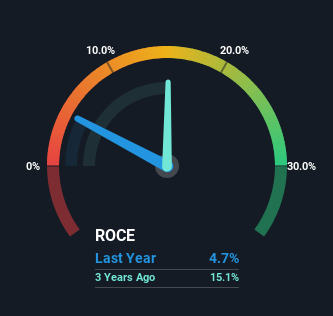Triumph New Energy (HKG:1108) Has More To Do To Multiply In Value Going Forward

Did you know there are some financial metrics that can provide clues of a potential multi-bagger? One common approach is to try and find a company with returns on capital employed (ROCE) that are increasing, in conjunction with a growing amount of capital employed. Basically this means that a company has profitable initiatives that it can continue to reinvest in, which is a trait of a compounding machine. Having said that, from a first glance at Triumph New Energy (HKG:1108) we aren't jumping out of our chairs at how returns are trending, but let's have a deeper look.
Understanding Return On Capital Employed (ROCE)
If you haven't worked with ROCE before, it measures the 'return' (pre-tax profit) a company generates from capital employed in its business. To calculate this metric for Triumph New Energy, this is the formula:
Return on Capital Employed = Earnings Before Interest and Tax (EBIT) ÷ (Total Assets - Current Liabilities)
0.047 = CN¥338m ÷ (CN¥12b - CN¥4.4b) (Based on the trailing twelve months to September 2023).
So, Triumph New Energy has an ROCE of 4.7%. Ultimately, that's a low return and it under-performs the Building industry average of 9.2%.
See our latest analysis for Triumph New Energy

Above you can see how the current ROCE for Triumph New Energy compares to its prior returns on capital, but there's only so much you can tell from the past. If you're interested, you can view the analysts predictions in our free report on analyst forecasts for the company.
What Does the ROCE Trend For Triumph New Energy Tell Us?
In terms of Triumph New Energy's historical ROCE trend, it doesn't exactly demand attention. The company has employed 301% more capital in the last five years, and the returns on that capital have remained stable at 4.7%. This poor ROCE doesn't inspire confidence right now, and with the increase in capital employed, it's evident that the business isn't deploying the funds into high return investments.
One more thing to note, even though ROCE has remained relatively flat over the last five years, the reduction in current liabilities to 38% of total assets, is good to see from a business owner's perspective. This can eliminate some of the risks inherent in the operations because the business has less outstanding obligations to their suppliers and or short-term creditors than they did previously.
Our Take On Triumph New Energy's ROCE
As we've seen above, Triumph New Energy's returns on capital haven't increased but it is reinvesting in the business. Although the market must be expecting these trends to improve because the stock has gained 71% over the last five years. However, unless these underlying trends turn more positive, we wouldn't get our hopes up too high.
If you want to continue researching Triumph New Energy, you might be interested to know about the 2 warning signs that our analysis has discovered.
While Triumph New Energy may not currently earn the highest returns, we've compiled a list of companies that currently earn more than 25% return on equity. Check out this free list here.
Valuation is complex, but we're here to simplify it.
Discover if Triumph New Energy might be undervalued or overvalued with our detailed analysis, featuring fair value estimates, potential risks, dividends, insider trades, and its financial condition.
Access Free AnalysisHave feedback on this article? Concerned about the content? Get in touch with us directly. Alternatively, email editorial-team (at) simplywallst.com.
This article by Simply Wall St is general in nature. We provide commentary based on historical data and analyst forecasts only using an unbiased methodology and our articles are not intended to be financial advice. It does not constitute a recommendation to buy or sell any stock, and does not take account of your objectives, or your financial situation. We aim to bring you long-term focused analysis driven by fundamental data. Note that our analysis may not factor in the latest price-sensitive company announcements or qualitative material. Simply Wall St has no position in any stocks mentioned.
About SEHK:1108
Triumph New Energy
Engages in research and development, manufacturing, and sales of new energy materials.
High growth potential and slightly overvalued.
Market Insights
Community Narratives




